8324-1 Bogong High Plains North
8324-1 to 3 Bogong High Plains
Page top
This information has been developed from the publications:
|
Location: | Eastings 230 to 380, Northings 200 to 270. Area of Mount Bogong, Spion Kopje, Mount Nelse. | 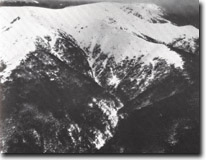 The Mount Bogong massif. |
Abstract: | Exposures of Omeo Metamorphic Complex, deeply dissected topography, structurally controlled drainage and periglacial land forms. | |
Access: | Walk from Mountain Creek Road or from Granite Flat. | |
Ownership: | Crown Land. | |
Geology: 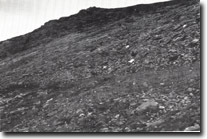 Mount Nelse. Periglacial slope deposits. | Schists and gneisses of the Omeo Metamorphic Complex are the predominant rock types outcropping in the northern Bogong High Plains. These have been divided into two units, Mount Nelse Schist and High Plains Gneiss, both of which are well exposed in the higher peaks- Mount Bogong, Spion Kopje and Mount Nelse- and in the deeply incised valleys of the streams draining the High Plains, eg. Big River, Cairn Creek and Holland Creek. The Mount Nelse Schists are rich in biotite and cordierite, are often knotted, and pass transitionally into the higher-grade metamorphics of the High Plains Gneiss. The latter, which forms the core of the metamorphic complex, is strongly banded magmatic cordierite- sillimanite gneiss. The lowest grade schists of the main belt are exposed on T Spur and Mount Bogong. These are fine-textured strongly foliated rocks with a localised tendency to banding. Porphyroblasts up to five millimetres in diameter stand out as small relief features on the weathered rock surface. Medium- grade metamorphic biotite schists are well exposed on the northern slopes of Mount Bogong in the area of Camp Creek, while higher grade schists and knotted schists are exposed in Cairn Creek, the Big River valley and on Mount Nelse. The knotted schist occurring on Mount Nelse is of a higher grade than that occurring in the Mount Bogong area. Interbedded with the knotted schists at Mount Nelse are strongly foliated, fine to medium textured quartz-hornblende-almandine schists. On both Mount Nelse and Mount Bogong, the knotted schists pass into higher-grade metamorphics, sillimanite-rich schists occur locally on Mount Bogong and strongly foliated sillimanite-cordierite gneiss occurs closer to the granite contacts in the Spion Kopje area. Kiewa Granodiorites have intruded the metamorphic complex, these are typically light grey, medium and evenly grained rocks which show no banding or parallel arrangements of any constituent minerals. These rocks occur as isolated pods between Mount Nelse and Mount Bogong, and to the west of Spion Kopje. The schists, gneisses and granodiorites of this area intruded by large number of dykes, chiefly lamprophyres and occasional feldspar porphyrites, mochiquites and basaltic dykes. The emplacement of these is linked with the intrusion of the Big Hill Quartz Diorite to the west o the High Plains, the dykes trend either east-west or approximately 20º south of east. They are exposed on the Mount Bogong- Mount Bogong Central ridge, in the headwaters of Camp Creek, in the Big River Valley and on Spion Kopje. Folding of the metamorphic rocks is evident in the High Plains area, although some uncertainty exists concerning the nature, and origin, of their foliation. Apart from local isoclinical folding of schists in Camp Creek (Mount Bogong), the fold structures in the metamorphics are indistinct on the ground. It has been suggested that the high-grade schists and gneisses have undergone one period of deformation and may have represented a stable block when further deformation of the Ordovician sediments to the south of the Bogong area. Occurred. Faults dominate the structure of the Bogong High Plains North. Major faults occurring in this area are the Spion Kopje Fault, which is marked by a zone of brecciated mylonite along which Spion Kopje Creek, has excavated a valley, and the Nelse Fault along which the schists- gneiss transition has been laterally displaced. The Nelse fault, represented by a belt of mylonite with outcrop width of 20 metres, forms a strong linearity with a number of small streams developed along the crush zone. | |
Geomorphology: 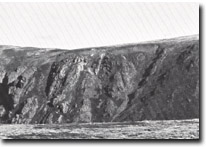 Schists of the Mount Bogong massif at Cairn Creek. | The accordance of the major peaks suggests that the High Plains area is a remnant of a former peneplain. The High Plains North area is divided by the deeply incised Big River Valley into two distinct units; the flat- topped spurs of the Mount Nelse- Spion Kopje area and the small area of relatively gentle slopes capping the Mount Bogong ridge. Uplift of the High Plains are due to movement along the Tawonga Fault, and other parallel faults, caused stream rejuvenation and resulted in the formation of deeply incised valleys. That this uplift was intermittent is indicated by the “valley in valley” structure of the main river systems. Down cutting by the major rivers, eg. Big River, has been faster than their smaller tributary streams and thus hanging valleys, waterfalls, cascades and short gorge sections are a common feature of drainage systems in this area. These features are well displayed by the streams draining to the south from the Mount Bogong ridge, eg. Cairn Creek and Camp Creek. The drainage pattern in this area is strongly influenced by geological structure. Streams have often excavated the mylonites or breccias associated with faults and prominent lineaments. The Spion Kopje lineament is a clear example of this type of differential erosion. Three minor faults across the valley of the Big River in the area to the south of Mount Bogong and have resulted in changes in channel orientation. It is unclear whether the channel dislocations resulted from differential erosion along the crush zones associated with the faults, or whether they have resulted from relatively recent movements along the faults. Unlike the Kosciusko area, no unequivocal evidence of Pleistocene glacial activity has been identified in the Victorian Highlands. However, periglacial activity is recognised as having been an important geomorphological process in the evolution of High Plains landforms. It has been suggested that stream valleys in the Mount Bogong and Spion Kopje areas show evidence of ice action. The valleys head in depressions below which their courses are U-shaped and gorge-like. These valley-head depressions have been interpreted as cirques and it has been interred that the valley cross-sections are the result of glacial scour. However, periglacial processes together with mass wasting and rapid down cutting by steams through the weathered metamorphics may provide a satisfactory mechanism for the formation of the valleys. Relict periglacial features such as small solifluction lobes occur on the eastern side of Mount Nelse, while mass wasting features emphasise the instability of the regolith cover on the steep slopes of the northern High Plains area. These mass-wasting features emphasise the instability of the regolith cover on the steep slopes of the northern High Plains area, while trampling of vegetation on, and around, pedestrian tracks on the flat ridge tops of Mount Bogong has resulted in substantial gullying where these tracks concentrate run off. Isolated hornblende- lamprophyre rocks exhibiting faceting occur in the headwaters of Cairn Creek. These have been interpreted as glacial erratics although more recent investigation has indicated that hornblende- lamprophyre dykes are common in the area and that these so- called erratics are most probably derived from the dykes. The faceting of these boulders, also suggested as indicating glacial erosion, appears instead to be related to shearing of the dykes rocks, resulting in the production of rhomboidal joint-bound blocks. | |
Significance: | National. This area represents a major component of the limited alpine and sub-alpine terrain on continental Australia. The Bogong High Plains North area includes the highest mountain in Victoria- Mount Bogong, while Mount Nelse North are only exceeded in altitude by Mount Feathertop. The flat topped spurs of the area in altitude by Mount Feathertop. The flat topped spurs of the area contrast with the surrounding deeply dissected topography, which resulted in a large relative relief. This area provides the best example in Victoria of a high-altitude alpine ridge environment. The drainage pattern is distinctly structurally controlled and many of the streams have formed valleys along fault crush zones or in mylonites associated with faults, thus forming a prominent rectangular drainage pattern. Periglacial landforms and the possibility that glacial forms may be revealed by further investigation are of additional interest. | |
Management: | To maintain the scientific significance of the area, it is recommended that minimum disturbance be permitted in the sub-alpine and treeless zones. Detailed study of slope materials and slopes stability is a necessary prerequisite to the development of many visitor facilities, eg. Walking tracks, camping areas, and excavations and road works should be kept to a minimum. | |
References: | Stirling, J. 1886. 'Note on Mount Bogong'. Trans. Geol. Soc. Australasia, 1 :134-136. Carr, S.G.M. and Costin, A.B. 1955. 'Pleistocene glaciation in the Victorian Alps', Proc.Linn. Soc. N.S.W., 80 :217-228. Beavis, F.C. 1959. 'Pleistocene glaciation on the Bogong High Plains', Aust. J. Sci. 21 :192. Beavis, F.C. 1962. 'The geology of the Kiewa area', Proc. R. Soc. Vict. 75 :349-510. Peterson, J.A. 1971. 'The equivocal extent of glaciation in the southeastern uplands of Australia', Proc. R. Soc. Vict., 84 :207-211. McAndrew, J. and Marsden, M.A.H. (eds) 1973. Regional guide to Victorian Geology. Second Edition, School of Geology, University of Melbourne. | |
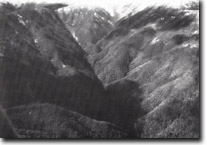 Spion Kopje Fault. | 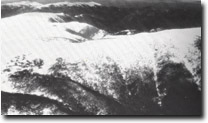 Edge of plateau - Bogong High Plains north of Mount Nelse. | |



